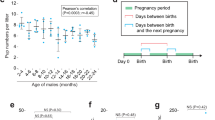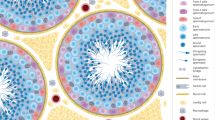Abstract
IN androgen-resistant male mice of genotype Tfm/Y spermatogenesis is arrested at first meiotic division. This is likely to be due, at least in part, to the need for testosterone if spermatogenesis is to proceed beyond prophase of first meiosis1. It would be somewhat surprising if the response to androgen involved any gene action in the developing sperm cell itself, since the locus of the gene for response to androgen, Tfm, is on the X chromosome2. The X–Y chromosome pair is believed to become genetically inactive during meiotic prophase3, and at stages beyond meiosis I only 50% of spermatocytes and spermatids possess an X chromosome.
This is a preview of subscription content, access via your institution
Access options
Subscribe to this journal
Receive 51 print issues and online access
$199.00 per year
only $3.90 per issue
Buy this article
- Purchase on Springer Link
- Instant access to full article PDF
Prices may be subject to local taxes which are calculated during checkout
Similar content being viewed by others
References
Steinberger, E., Steinberger, A., and Sanborn, B., in Physiology and Genetics of Reproduction, A, (edit. by Coutinho, E. M., and Fuchs, F.), 163–181 (Plenum, New York, 1974).
Lyon, M. F., and Hawkes, S. G., Nature, 227, 1217–1219 (1970).
Monesi, V., Chromosoma, 17, 11–21 (1965).
Tarkowski, A. K., Nature, 190, 857–860 (1961).
Mintz, B., A. Rev. Genet., 8, 411–470 (1974).
Drews, U. S. R., Owen, D. A., and Ohno, S., Cell, 1, 3–8 (1974).
Cattanach, B. M., Wolfe, H. G., and Lyon, M. F., Genet. Res., 19, 213–228 (1972).
Mintz, B., in Methods in Developmental Biology (edit. by Wilt, F. H., and Wessells, N. K.), 379–400 (Crowell, New York, 1967).
Ohno, S., Nature, 234, 134–137 (1971).
Bardin, C. W., Bullock, L. P., Sherins, R. J., Mowszowicz, I., and Blackburn, W. R., Rec. Prog. Hormone Res., 29, 65–109 (1973).
Vernon, R. G., Kopec, B., and Fritz, I. B., Molec. Cell Endocr., 1, 167–187 (1974).
Weddington, S. C., Hansson, V., Ritzén, E. M., Hagenas, L., French, F. S., and Nayfeh, S. N., Nature, 254, 145–146 (1975).
Attardi, B., and Ohno, S., Cell, 2, 205–212 (1974).
Bullock, L. P., and Bardin, C. W., Endocrinology, 94, 746–756 (1974).
Gehring, U., and Tomkins, G. M., Cell, 3, 59–64 (1974).
Hansson, V., et al., Nature, 250, 387–391 (1974).
Oakberg, E. F., in Physiology and Genetics of Reproduction, A, (edit. by Coutinho, E. M., and Fuchs, F.), 197–207 (Plenum, New York, 1974).
Blaquier, J. A., Cameo, M. S., and Burgos, M. H., Endocrinology, 90, 839–842 (1972).
Dyson, A. L. M. B., Orgebin-Crist, M. C., Endocrinology, 93, 391–402 (1973).
Drews, U., and Alonso-Lozano, V., J. Embryol. exp. Morph., 32, 217–225 (1974).
Author information
Authors and Affiliations
Rights and permissions
About this article
Cite this article
LYON, M., GLENISTER, P. & LYNN LAMOREUX, M. Normal spermatozoa from androgen-resistant germ cells of chimaeric mice and the role of androgen in spermatogenesis. Nature 258, 620–622 (1975). https://doi.org/10.1038/258620a0
Received:
Accepted:
Published:
Issue Date:
DOI: https://doi.org/10.1038/258620a0
This article is cited by
-
The antiandrogenic vinclozolin induces differentiation delay of germ cells and changes in energy metabolism in 3D cultures of fetal ovaries
Scientific Reports (2020)
-
Long-term culture and significant expansion of human Sertoli cells whilst maintaining stable global phenotype and AKT and SMAD1/5 activation
Cell Communication and Signaling (2015)
-
Hormonal control of Sertoli cell metabolism regulates spermatogenesis
Cellular and Molecular Life Sciences (2013)
Comments
By submitting a comment you agree to abide by our Terms and Community Guidelines. If you find something abusive or that does not comply with our terms or guidelines please flag it as inappropriate.



